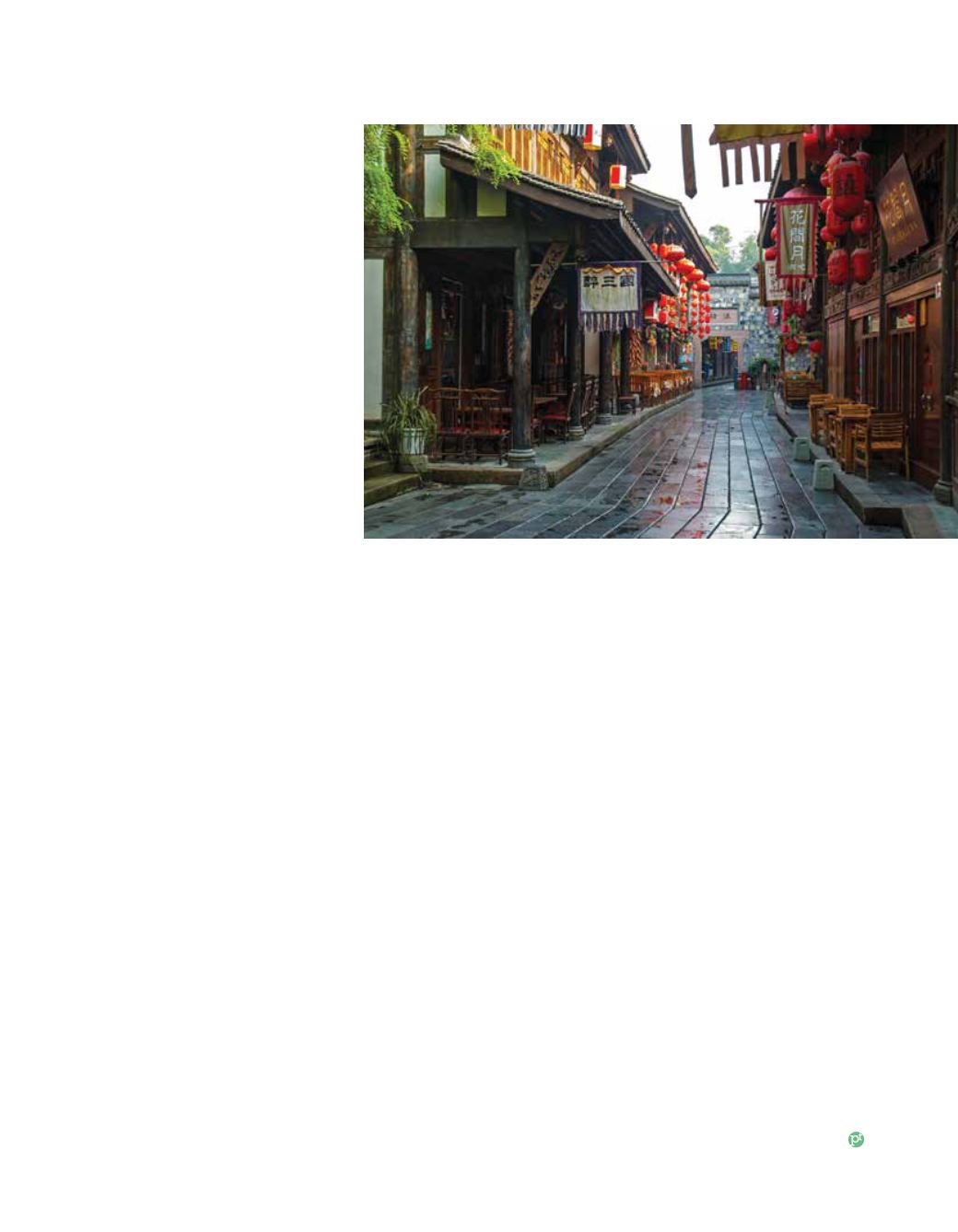
its feeding habits. The finale of the
tour is a chance to meet a panda and
have your photo taken. I will never
forget the look on my daughter’s face
as she cuddled up to a cub, who gazed
back at her with an amused look
(apparently they like small people).
Parks and recreation
One of the best ways to experience
daily Chinese life is to visit one of
Chengdu’s many parks. Here you’ll
find folks ballroom dancing in the
middle of the day, playing card
games, flying kites, feeding fish
and meandering around the lake.
Chengdu’s parks also have teahouses
dotted around, where you can sit and
order a delicious Longjing green tea
and watch the world go by (or, in our
case, often watch the world stare back
at us). Wangjianglou Park is split into
two parts, a large free section and a
paid ‘exclusive’ area. It’s worth paying
the small fee to enjoy the bamboo
creations, old pagodas and peaceful
oasis. The Renmin (People’s) Park is
another great spot for people-watching
and even has some rowing boats
should you fancy a spin on the lake.
Chengdu has several recreated
ancient streets, which are now filled
with souvenir sellers, street food and
teahouses. Whilst some might say
they are super-touristy, I would say
they are lots of fun, especially for the
kids. Jinli is the most famous of these
‘ancient streets’ and you could easily
spend a few hours people-watching,
braving the street food (pig intestines
anyone?) and buying yet more panda
goodies. Kuan Zhai Alley has three
parallel roads filled with hutongs
(ancient courtyard houses) that now
contain shops and cafes. There is also
some interesting interactive street art
nestled between the boutiques and
coffee shops. If the crowds are too
much and you’re in search of some
Zen, head to the Wenshu Monastery.
This collection of tranquil Buddhist
temples also has a beautiful garden
and apparently the best vegetarian
food in the city (although we were too
full from our Jinli street food to test it
out).
Spice of life
You can’t come to Chengdu and
not push your tastebuds to their
spicy limit. Sichuan food is famous
for its bold flavours including the
famous Sichuan pepper. We found
the Shangri La breakfast buffet in
Café Z to be a great introduction to
Sichuan cuisine! Nestled alongside
the croissants and pain au chocolat
were dan dan noodles and traditional
spicy dumplings. This was the perfect
culinary playground for my five-year-
old, who would test out a dumpling
and then counter the spice with a
soothing chocolate milk.
I had read that a night at the
Sichuan Opera was simply a must.
Envisaging three hours of wailing
Chinese opera, I was hesitant to
purchase tickets. Luckily, I read the
rave reviews on Tripadvisor and
changed my mind. Think more
Cirque du Soleil than traditional
opera. The acrobatics, fire eating and
mask changing were absolutely superb.
Finally, a few tips on travelling
with young kids in China. They will
(especially blonde-haired/blue-eyed
ones) garner attention. That said, we
have encountered worse experiences
walking down Avenue of the Stars in
Hong Kong. If your kids are bothered
by it, teach them to politely say “
Wo
bu xihuan
” (“I don’t like it”) and walk
away. Outside of our hotel, I found
relatively little English spoken, so it’s
worth carrying a pocket guidebook
and learning some key phrases. I also
had the concierge write down the
addresses for all the places we wanted
to go, so we could easily hop in and
out of taxis.
Overall, Chengdu is a sizzling city
with lots to offer. Whilst our three-day
break was perfectly suited to a five-
year-old’s attention span, I would have
happily stayed on for longer. Outside
the city are some fantastic day trips
to be had, from Leshan Buddha and
Mount Emai, to Mount Qingcheng
and the Dujiangyan Irrigation System.
If that hasn’t won you over, just
think about the chance to cuddle up
to a real-life panda – that’s one life
experience that can’t be beaten.
May 2015
91


